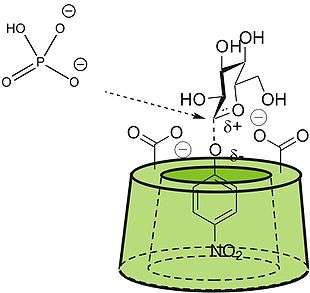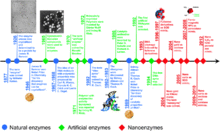Artificial enzyme

An artificial enzyme is a synthetic, organic molecule or ion that recreate some function of an enzyme. The area promises to deliver catalysis at rates and selectivity observed in many enzymes.
History
Enzyme catalysis of chemical reactions occur with high selectivity and rate. The substrate is activated in a small part of the enzyme's macromolecule called the active site. There, the binding of a substrate close to functional groups in the enzyme causes catalysis by so-called proximity effects. It is possible to create similar catalysts from small molecule by combining substrate-binding with catalytic functional groups. Classically artificial enzymes bind substrates using receptors such as cyclodextrin, crown ethers, and calixarene.[1][2]
Artificial enzymes based on amino acids or peptides as characteristic molecular moieties have expanded the field of artificial enzymes or enzyme mimics. For instance, scaffolded histidine residues mimics certain metalloproteins and -enzymes such as hemocyanin, tyrosinase, and catechol oxidase).[3]
Nanozymes
Nanozymes are nanomaterials with enzyme-like characteristics.[4] They have been widely explored for various applications, such as biosensing, bioimaging, tumor diagnosis and therapy, antibiofouling.[5][6][7][8] In 2006, nanoceria (i.e., CeO2 nanoparticles) was used for preventing retinal degeneration induced by intracellular peroxides.[9][10] In 2007, Xiyun Yan and coworkers reported that ferromagnetic nanoparticles possessed intrinsic peroxidase-like activity.[11][12] In 2008, Hui Wei and Erkang Wang developed an iron oxide nanozyme based sensing platform for bioactive molecues (such as hydrogen peroxide and glucose).[13] In 2012, recombinant human heavy-chain ferritin coated iron oxide nanoparticle with peroxidase-like activity was prepared and used for targeting and visualizing tumour tissues.[14] In 2012, vanadium pentoxide nanoparticles with vanadium haloperoxidase mimicking activities were used for preventing marine biofouling.[15] In 2015, a supramolecular regulation strategy was proposed to modulate the activity of gold-based nanozymes for imaging and therapeutic applications.[16][17] A nanozyme-strip for rapid local diagnosis of Ebola was developed.[18][19] An integrated nanozyme has been developed for real time monitoring the dynamic changes of cerebral glucose in living brains.[20][21] A book entitled "Nanozymes: Next Wave of Artificial Enzymes" was published.[22] Oxidase-like nanoceria has been used for devloping self-regulated bioassays.[23]
Nanozymes (Conferences & Meetings)
Several conferences (meetings) have been focused on the nanozymes. In 2015, a workshop for nanozyme has been held in 9th Asian Biophysics Associatation (ABA) Symposium.[24] In Pittcon 2016, a Networking entitled "Nanozymes in Analytical Chemistry and Beyond" was devoted to nanozymes.[25]

See also
References
- ↑ "Wiley: Artificial Enzymes - Ronald Breslow". as.wiley.com. Retrieved 2015-12-11.
- ↑ Kirby, Anthony J; Hollfelder, Florian (2009-10-01). From Enzyme Models to Model Enzymes. doi:10.1039/9781847559784. ISBN 9780854041756.
- ↑ Scaffolded amino acids as a close structural mimic of type-3 copper binding sites. H. Bauke Albada, Fouad Soulimani, Bert M. Weckhuysen and Rob M. J. Liskamp, Chem. Commun., 2007, pages 4895-4897, doi:10.1039/B709400K
- ↑ Wei, Hui; Wang, Erkang (2013-06-21). "Nanomaterials with enzyme-like characteristics (nanozymes): next-generation artificial enzymes". Chemical Society Reviews. 42 (14). doi:10.1039/C3CS35486E. ISSN 1460-4744.
- ↑ 阎锡蕴. 纳米材料新特性及生物医学应用 (第1版 ed.). 北京: 科学出版社. ISBN 9787030418289.
- ↑ Wang, Zerong. Encyclopedia of Physical Organic Chemistry, 5 Volume Set (Edición: Volumes 1 - 5. ed.). Place of publication not identified: John Wiley & Sons Inc. ISBN 9781118470459.
- ↑ "Nanozyme brief history".
- ↑ Wang, Xiaoyu; Hu, Yihui; Wei, Hui. "Nanozymes in bionanotechnology: from sensing to therapeutics and beyond". Inorg. Chem. Front. 3 (1): 41–60. doi:10.1039/c5qi00240k.
- ↑ Chen, Junping; Patil, Swanand; Seal, Sudipta; McGinnis, James F. (2006-11-01). "Rare earth nanoparticles prevent retinal degeneration induced by intracellular peroxides:". Nature Nanotechnology. 1 (2): 142–150. doi:10.1038/nnano.2006.91. ISSN 1748-3387.
- ↑ Silva, Gabriel A. (2006-11-01). "Nanomedicine: Seeing the benefits of ceria". Nature Nanotechnology. 1 (2): 92–94. doi:10.1038/nnano.2006.111. ISSN 1748-3387.
- ↑ Gao, Lizeng; Zhuang, Jie; Nie, Leng; Zhang, Jinbin; Zhang, Yu; Gu, Ning; Wang, Taihong; Feng, Jing; Yang, Dongling (2007-09-01). "Intrinsic peroxidase-like activity of ferromagnetic nanoparticles". Nature Nanotechnology. 2 (9): 577–583. doi:10.1038/nnano.2007.260. ISSN 1748-3387.
- ↑ Perez, J. Manuel (2007-09-01). "Iron oxide nanoparticles: Hidden talent". Nature Nanotechnology. 2 (9): 535–536. doi:10.1038/nnano.2007.282. ISSN 1748-3387.
- ↑ Wei, Hui; Wang, Erkang (2008-03-15). "Fe3O4 Magnetic Nanoparticles as Peroxidase Mimetics and Their Applications in H2O2 and Glucose Detection". Analytical Chemistry. 80 (6): 2250–2254. doi:10.1021/ac702203f. ISSN 0003-2700.
- ↑ Fan, Kelong; Cao, Changqian; Pan, Yongxin; Lu, Di; Yang, Dongling; Feng, Jing; Song, Lina; Liang, Minmin; Yan, Xiyun (2012-07-01). "Magnetoferritin nanoparticles for targeting and visualizing tumour tissues". Nature Nanotechnology. 7 (7): 459–464. doi:10.1038/nnano.2012.90. ISSN 1748-3387.
- ↑ Natalio, Filipe; André, Rute; Hartog, Aloysius F.; Stoll, Brigitte; Jochum, Klaus Peter; Wever, Ron; Tremel, Wolfgang (2012-08-01). "Vanadium pentoxide nanoparticles mimic vanadium haloperoxidases and thwart biofilm formation". Nature Nanotechnology. 7 (8): 530–535. doi:10.1038/nnano.2012.91. ISSN 1748-3387.
- ↑ Tonga, Gulen Yesilbag; Jeong, Youngdo; Duncan, Bradley; Mizuhara, Tsukasa; Mout, Rubul; Das, Riddha; Kim, Sung Tae; Yeh, Yi-Cheun; Yan, Bo (2015-07-01). "Supramolecular regulation of bioorthogonal catalysis in cells using nanoparticle-embedded transition metal catalysts". Nature Chemistry. 7 (7): 597–603. doi:10.1038/nchem.2284. ISSN 1755-4330.
- ↑ Unciti-Broceta, Asier (2015-07-01). "Bioorthogonal catalysis: Rise of the nanobots". Nature Chemistry. 7 (7): 538–539. doi:10.1038/nchem.2291. ISSN 1755-4330.
- ↑ Duan, Demin; Fan, Kelong; Zhang, Dexi; Tan, Shuguang; Liang, Mifang; Liu, Yang; Zhang, Jianlin; Zhang, Panhe; Liu, Wei (2015-12-15). "Nanozyme-strip for rapid local diagnosis of Ebola". Biosensors and Bioelectronics. 74: 134–141. doi:10.1016/j.bios.2015.05.025.
- ↑ Elsevier. "New Ebola test to make diagnosis easier, faster and cheaper". www.elsevier.com. Retrieved 2016-06-10.
- ↑ Cheng, Hanjun; Zhang, Lei; He, Jian; Guo, Wenjing; Zhou, Zhengyang; Zhang, Xuejin; Nie, Shuming; Wei, Hui (2016-04-12). "Integrated nanozymes with nanoscale proximity for in vivo neurochemical monitoring in living brains". Analytical Chemistry. doi:10.1021/acs.analchem.6b00975. ISSN 0003-2700.
- ↑ "Integrated nanozymes for brain chemistry". phys.org. Retrieved 2016-04-17.
- ↑ Nanozymes: Next Wave of Artificial Enzymes | Xiaoyu Wang | Springer.
- ↑ Cheng, Hanjun; Lin, Shichao; Muhammad, Faheem; Lin, Ying-Wu; Wei, Hui (2016-10-25). "Rationally modulate the oxidase-like activity of nanoceria for self-regulated bioassays". ACS Sensors. doi:10.1021/acssensors.6b00500.
- ↑ "Workshop for nanozymes".
- ↑ "Nanozymes at Pittcon 2016".